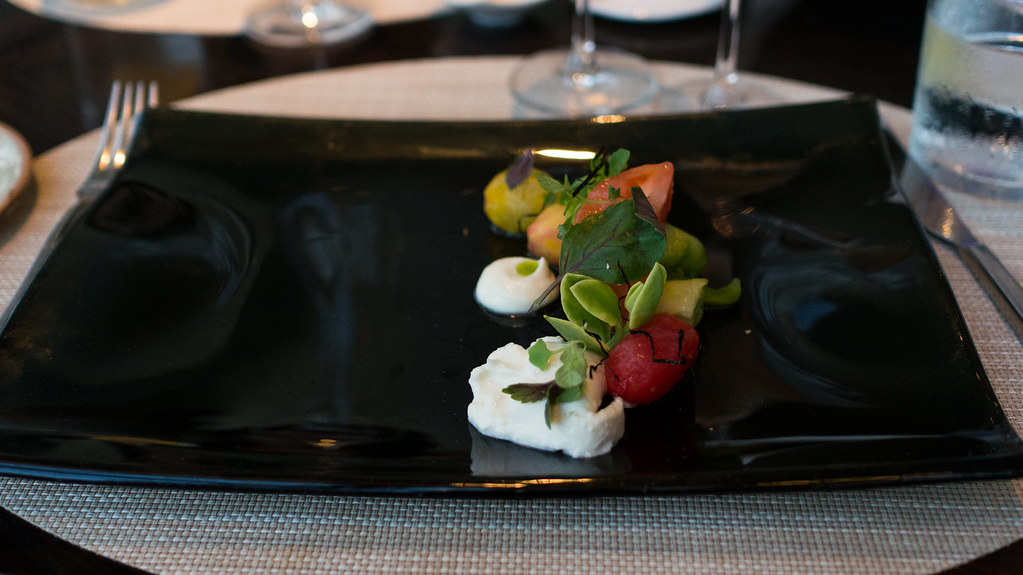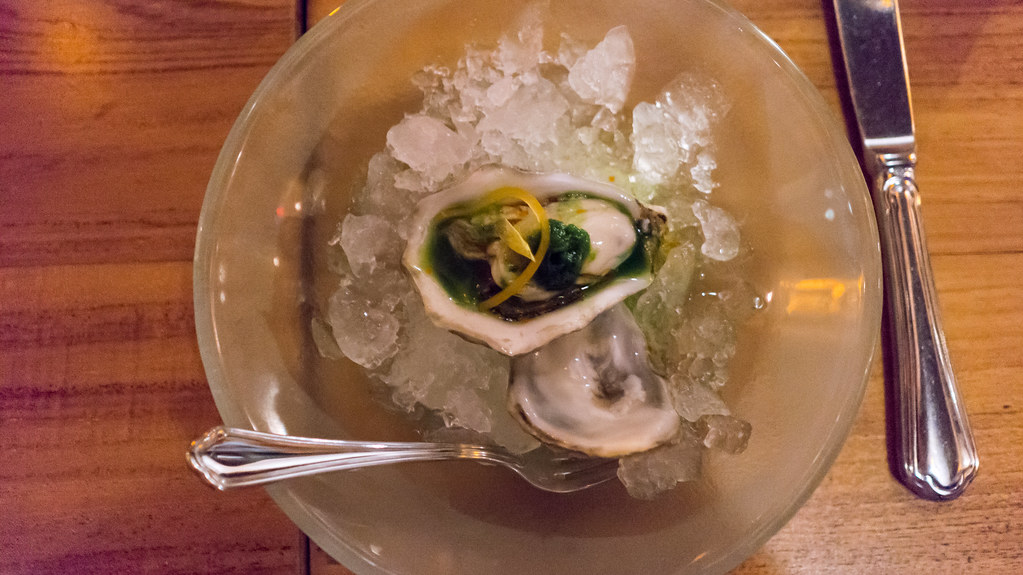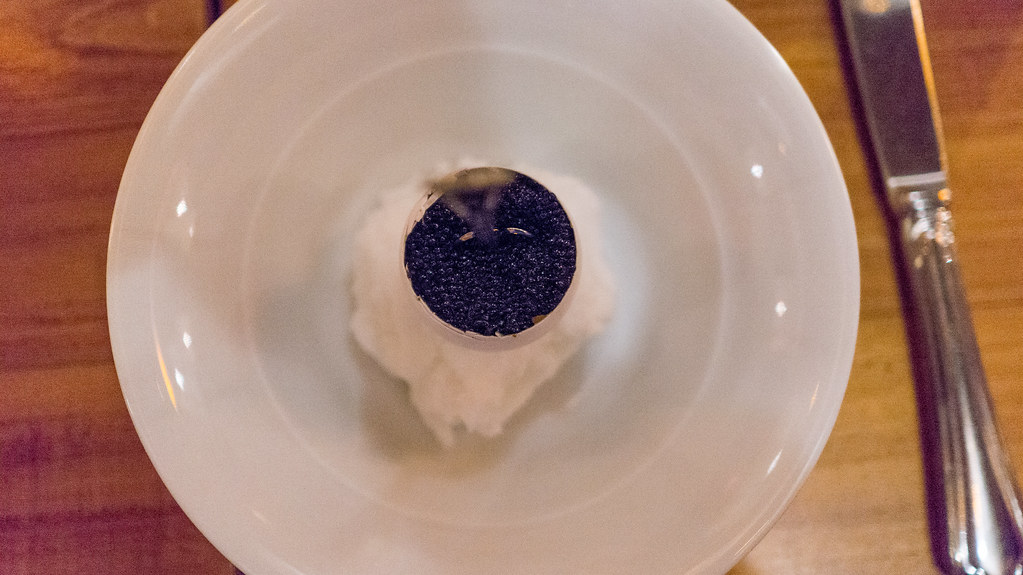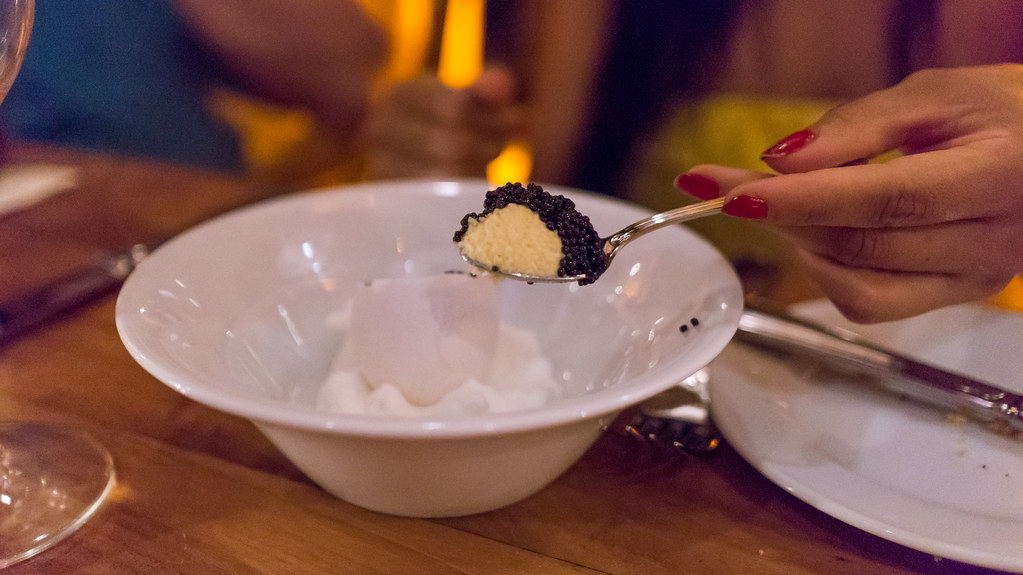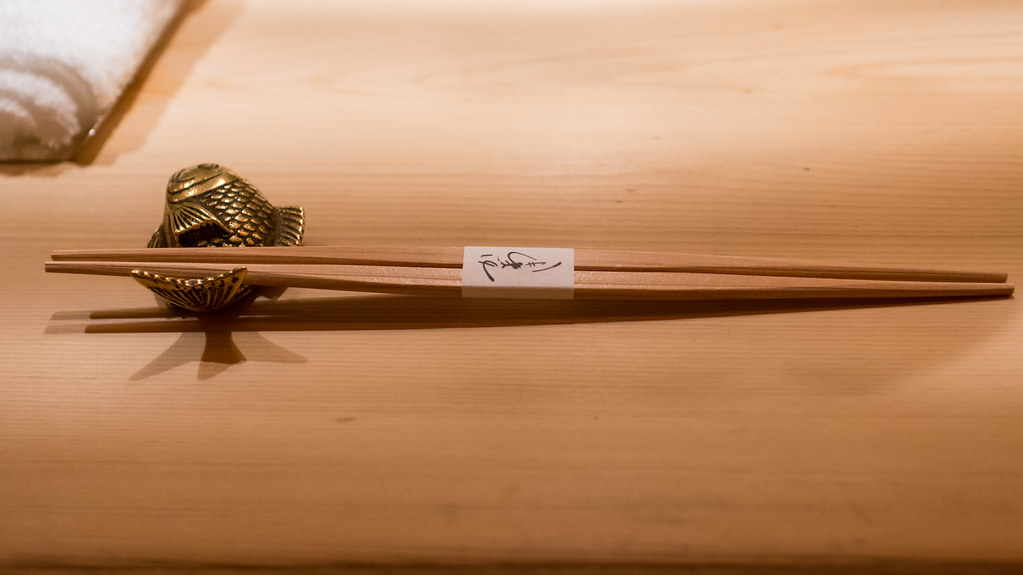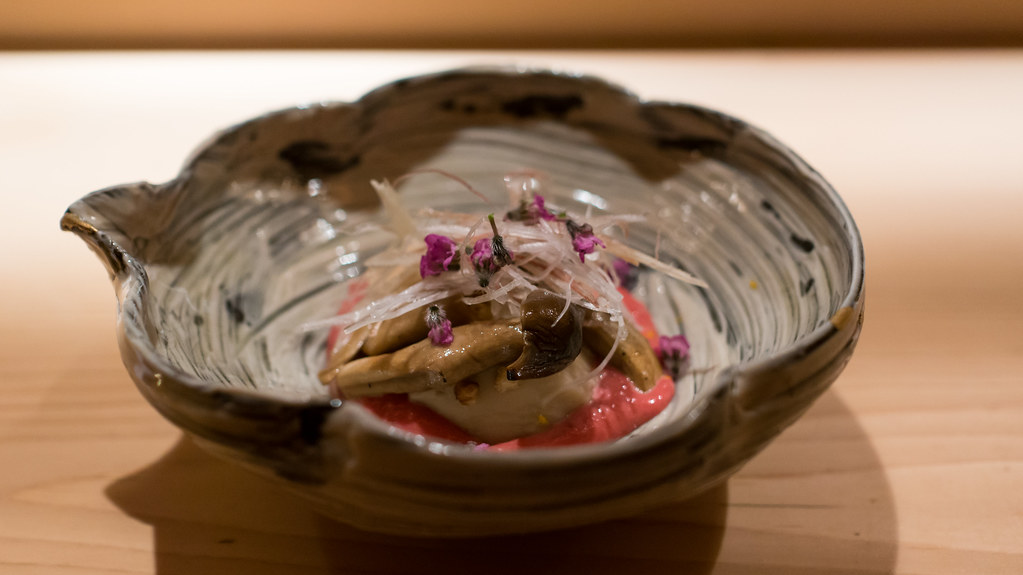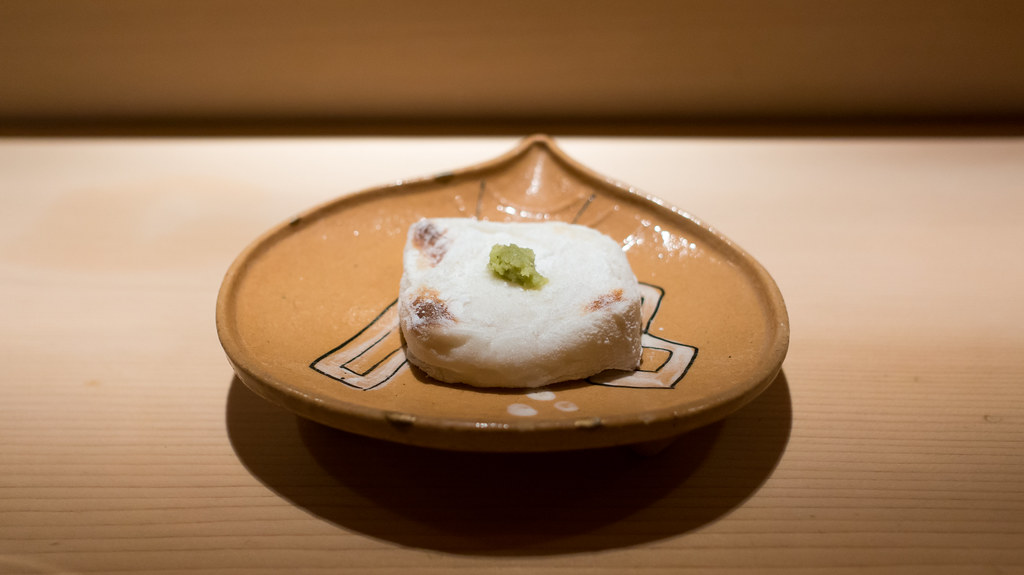I usually don't write about restaurants based on off-the-menu experiences, particularly those of the "cook for me" variety.[1] But exceptionalism is cause for making exceptions. Chef de Cuisine Bradley Kilgore and Executive Pastry Chef Antonio Bachour are doing exceptional things right now at J&G Grill in Bal Harbour, and it seems foolish not to speak of them.
I've been talking Brad up for years, going back to our Cobaya dinner at Azul in 2011 where he was a sous chef at the time. After a brief stint heading the short-lived Exit 1 on Key Biscayne, Brad landed as chef de cuisine at Jean-Georges Vongerichten's J&G Grill in the St. Regis, where he's finally had the resources to match his talent and ambition. He also has had the benefit of teaming up with Antonio Bachour, whose pastry work is, and I don't exaggerate, brilliant.
To celebrate a recent birthday, the family let me choose where to go,[2] and I quickly opted for J&G. The truth is, while I've tasted Brad and Antonio's work on several occasions, most often it has been at special event type things.[3] I wanted to have a full-blown dinner there, and yes, I did kind of want to lay it on thick: it was a birthday after all. So I asked them to do a tasting menu for the family. And it was easily one of the best meals I've had in Miami this year.
To start, oysters "in their natural setting:" a freshly shucked oyster, swimming in a mignonette gelee, perched on a mound of squid ink and salt "sand," with various seaweeds strewn about and puffs of verjus foam washing up here and there. It's a gorgeous presentation of the clean, fresh flavors of the ocean – the only flaw is that the squid ink "sand" is too salty to really be edible (something our server warned us of).
(You can see all my pictures in this J&G Grill flickr set.)
A variation on a dish from the regular menu: oozy burrata cheese, paired with ginger glazed heirloom tomatoes, tiny herbs and greens, and a drizzle of shiso oil. The ginger and shiso are unexpected accompaniments, each with a razor's edge sharpness that cuts through the lusciously creamy cheese. J&G's sommelier, Luis Mejia, was particularly proud of his pairing for this course – the Leitz Dragonstone Riesling – and for good reason, as its balance of honeyed fruit, spice and acidity was an ideal match for the dish.[4]
The next course was a variation on a dish Brad had served me a couple years ago: slices of togarashi cured cobia, topped with bits of citrus, a puffy basil meringue, and delicate but assertively flavored watercress flowers. Dessert techniques – meringues, mousses, and sabayons, for instance – regularly weave their way into Brad's savory dishes to good effect.
(continued ...)
Tuesday, June 24, 2014
Tuesday, May 27, 2014
Cobaya Conor at The Dutch
Almost exactly two years ago we did a "Cobaya" dinner – Experiment #24 – at The Dutch. Number 24 was one of only two Cobaya dinners over the course of the past nearly five years that I couldn't attend. It was a tough one to miss – Chef Andrew Carmellini came down from New York and put on a show that many veteran guinea pigs say was among the best we've ever had.[1]
Since then, I've been to a number of great events at The Dutch: the Hurricane Sandy Relief Dinner we helped coordinate in late 2012, a really classy Spring Equinox Dinner that The Dutch's local chef de cuisine Conor Hanlon put on last year with chef Brad Kilgore (before Brad was hired at JG Grill), an indulgent "Trufflepalooza" a few months ago. But what I really wanted was another Cobaya, this one with Conor getting to do his thing. It came together this past week, and fortunately, I didn't miss this one.
We had a smaller group than usual – only 25 – at Conor's request, so that he could really focus and do more complex, individually plated items, rather than the family style service we've had at prior events. His menu spanned ten courses, each round dramatically delivered to the table simultaneously for all diners at once by a swat team of servers.
We started with a raw Stellar Bay oyster on crushed ice, garnished with a spicy, vegetal nasturtium granite, roasted tomato oil, celery, and Meyer lemon: a lot of flavors packed into one bite, designed to duplicate the flavors of a Bloody Mary.
Another spin on classic flavors: Conor's "Eggs on Eggs" packed a silky deviled egg farce into a cleaned eggshell, and then spackled the surface with a generously thick layer of black bowfin caviar. The briny saline pop of the roe was a nice contrast against the creamy, mildly spicy egg mousse.
I was floored, though, by the next course. A creamy, tangy buttermilk panna cotta served as the base for a composition that was like a spring cornucopia: stalks and spears of white and green asparagus, fresh shucked peas, golden-orange smoked trout roe, pickled mustard seeds, a tangle of delicate greens and flowers, all nestled into a bed of crispy dark brown quinoa. Every bite yielded a different combination of flavors, textures and colors. Just an outstanding dish.
(continued ...)
Since then, I've been to a number of great events at The Dutch: the Hurricane Sandy Relief Dinner we helped coordinate in late 2012, a really classy Spring Equinox Dinner that The Dutch's local chef de cuisine Conor Hanlon put on last year with chef Brad Kilgore (before Brad was hired at JG Grill), an indulgent "Trufflepalooza" a few months ago. But what I really wanted was another Cobaya, this one with Conor getting to do his thing. It came together this past week, and fortunately, I didn't miss this one.
We had a smaller group than usual – only 25 – at Conor's request, so that he could really focus and do more complex, individually plated items, rather than the family style service we've had at prior events. His menu spanned ten courses, each round dramatically delivered to the table simultaneously for all diners at once by a swat team of servers.
We started with a raw Stellar Bay oyster on crushed ice, garnished with a spicy, vegetal nasturtium granite, roasted tomato oil, celery, and Meyer lemon: a lot of flavors packed into one bite, designed to duplicate the flavors of a Bloody Mary.
Another spin on classic flavors: Conor's "Eggs on Eggs" packed a silky deviled egg farce into a cleaned eggshell, and then spackled the surface with a generously thick layer of black bowfin caviar. The briny saline pop of the roe was a nice contrast against the creamy, mildly spicy egg mousse.
I was floored, though, by the next course. A creamy, tangy buttermilk panna cotta served as the base for a composition that was like a spring cornucopia: stalks and spears of white and green asparagus, fresh shucked peas, golden-orange smoked trout roe, pickled mustard seeds, a tangle of delicate greens and flowers, all nestled into a bed of crispy dark brown quinoa. Every bite yielded a different combination of flavors, textures and colors. Just an outstanding dish.
(continued ...)
Wednesday, May 21, 2014
"west meets east" | Azabu Kadowaki - 麻布かどわき- Tokyo
Japan would seem to have a massive trade surplus when it comes to culinary inspiration. From the minimalist lightness of French nouvelle cuisine of the 1970's, to America's never-ending if not always quality-driven fixation on sushi, to "fusion" in so many guises, to this past decade's ramen craze, the traffic in ideas appears to be largely outbound. But Japan also absorbs influences too; and when it does so, it's usually with the same intense dedication to craft that pervades virtually all other pursuits there.[1]
Azabu Kadowaki is a resolutely Japanese restaurant; in fact, chef Toshiya Kadowaki was famed for turning down stars when the Michelin guide first came to Japan, on the basis that “Japanese food was created here, and only Japanese know it ... How can a bunch of foreigners show up and tell us what is good or bad?” (He ultimately relented, as the restaurant now has two of those stars that Kadowaki initially shunned.) But it also clearly bears the mark of some Western influences, filtered through a Japanese prism.
If I have my genres right, Kadowaki is a "kappo ryori" restaurant – high end food served straight from the kitchen, usually by the chef himself presenting it across the counter. It is an elegantly appointed space: honed wood counters and cabinets with the precision workmanship of a luxury yacht, cooking instruments all encased in patterned ceramic. There were maybe eight seats at the bar that faced that gorgeous open kitchen, though there appeared to be a couple private rooms as well that servers flitted in and out of.
(You can see all my pictures in this Azabu Kadowaki flickr set.)
The meal is omakase style: other than a diner's selection between snow crab and fugu as a "main" course, and between three different price points (all designated when the reservation is booked), everything else is chef's choice.
Our dinner started with an unusual and beautiful dish: a block of rich, nutty sesame tofu, nestled in a bed of magenta-hued beet miso, crowned with some meaty roasted mushrooms and bright purple flower buds. It defied any stereotype of a tofu-based dish being bland or insubstantial.
Almost simultaneously, we were also served a block of what I believe was either mochi or konnyaku (a/k/a yam cake or devil's tongue jelly). Toasted around the edges, it was chewy, almost elastic in texture, and blandly starchy in flavor other than the dab of freshly grated wasabi. It was texturally intriguing, but I can't say much more about it than that.
The next course was one of my favorites, blending eastern and western components: a cube of winter daikon radish draped with a slice of roasted pear, all enrobed in a creamy cod roe sauce and topped with a fine julienne of fresh black truffle. Cooked daikon is a highly underrated ingredient: tender but still having substance, silky but with a pleasing bite of graininess against the teeth, and a mild sweet flavor. Those qualities were mirrored and amplified by the roasted pear, which brought a more intense caramelized sweetness, the mildly salty, creamy sauce, and the earthy, aromatic truffle. There were no bold flavors here – rather it was all subtlety and grace.
(continued ...)
Azabu Kadowaki is a resolutely Japanese restaurant; in fact, chef Toshiya Kadowaki was famed for turning down stars when the Michelin guide first came to Japan, on the basis that “Japanese food was created here, and only Japanese know it ... How can a bunch of foreigners show up and tell us what is good or bad?” (He ultimately relented, as the restaurant now has two of those stars that Kadowaki initially shunned.) But it also clearly bears the mark of some Western influences, filtered through a Japanese prism.
If I have my genres right, Kadowaki is a "kappo ryori" restaurant – high end food served straight from the kitchen, usually by the chef himself presenting it across the counter. It is an elegantly appointed space: honed wood counters and cabinets with the precision workmanship of a luxury yacht, cooking instruments all encased in patterned ceramic. There were maybe eight seats at the bar that faced that gorgeous open kitchen, though there appeared to be a couple private rooms as well that servers flitted in and out of.
(You can see all my pictures in this Azabu Kadowaki flickr set.)
The meal is omakase style: other than a diner's selection between snow crab and fugu as a "main" course, and between three different price points (all designated when the reservation is booked), everything else is chef's choice.
Our dinner started with an unusual and beautiful dish: a block of rich, nutty sesame tofu, nestled in a bed of magenta-hued beet miso, crowned with some meaty roasted mushrooms and bright purple flower buds. It defied any stereotype of a tofu-based dish being bland or insubstantial.
Almost simultaneously, we were also served a block of what I believe was either mochi or konnyaku (a/k/a yam cake or devil's tongue jelly). Toasted around the edges, it was chewy, almost elastic in texture, and blandly starchy in flavor other than the dab of freshly grated wasabi. It was texturally intriguing, but I can't say much more about it than that.
The next course was one of my favorites, blending eastern and western components: a cube of winter daikon radish draped with a slice of roasted pear, all enrobed in a creamy cod roe sauce and topped with a fine julienne of fresh black truffle. Cooked daikon is a highly underrated ingredient: tender but still having substance, silky but with a pleasing bite of graininess against the teeth, and a mild sweet flavor. Those qualities were mirrored and amplified by the roasted pear, which brought a more intense caramelized sweetness, the mildly salty, creamy sauce, and the earthy, aromatic truffle. There were no bold flavors here – rather it was all subtlety and grace.
(continued ...)
Subscribe to:
Posts (Atom)



